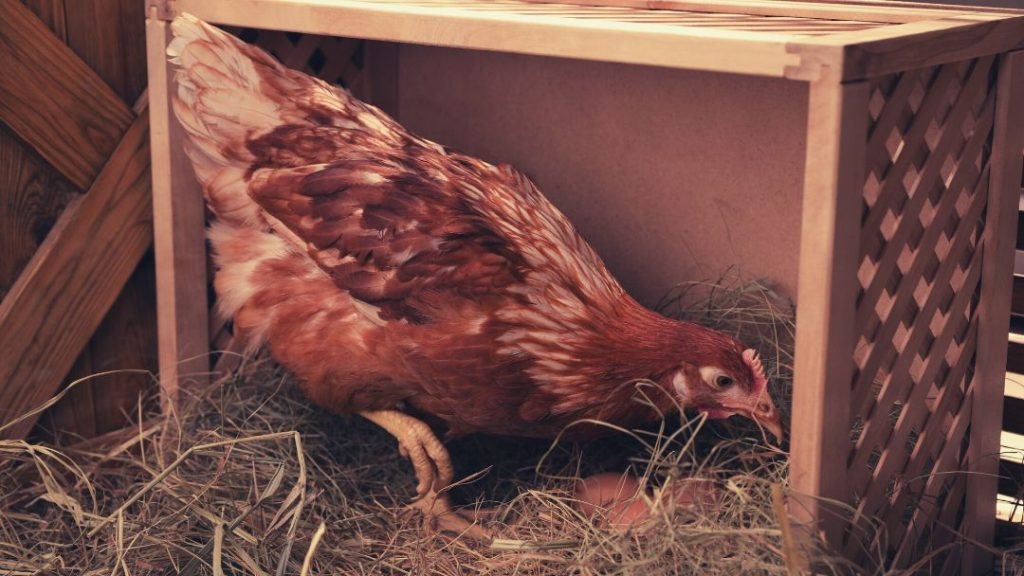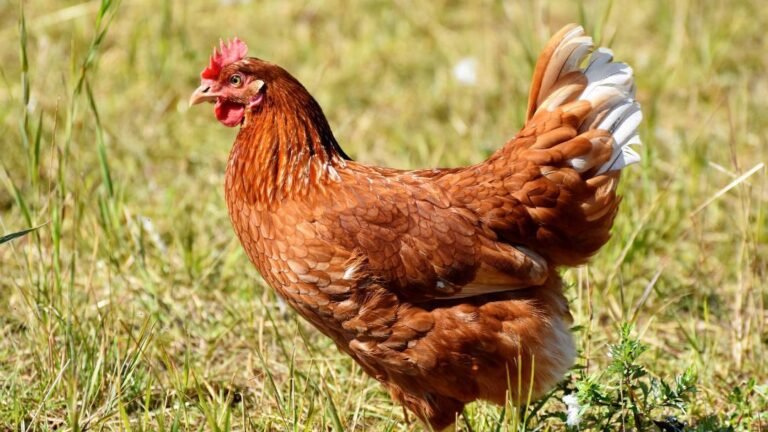Have you recently added nesting boxes inside or outside the chicken coop? Or, you might consider using them as your hens will likely lay eggs soon. Nesting boxes are essential to allow chickens to lay eggs peacefully. Do chicken nesting boxes need a top?
Adding a top to the nesting boxes is not mandatory. But, it will help shy and calm hens feel secure and safe by creating a darker environment. Nesting boxes with a roof also prevent chickens from visiting them unnecessarily. It allows you to keep them clean.
Do Chicken Nesting Boxes Need A Top?
It is not mandatory to use a lid or cover on nesting boxes. But your hens may feel more comfortable laying eggs if nesting boxes have a top.
It will create an enclosed and dark environment. Female chickens will feel safer and more secure.
Plus, a secured cover will minimize the excessive noise from the surrounding areas. This allows them to lay eggs in a quiet, out-of-the-way place.
Shy and calm hens will be encouraged to lay eggs as they feel less disturbed by other aggressive chickens.

Do Chickens Prefer Open Or Enclosed Nesting Boxes?
Like human beings, not all chickens will act in the same manner. Some may like open-style nesting boxes, and others prefer enclosed ones.
You can add both options and let them decide which options they prefer. Closely inspect their behaviors for a few days.
Remove the cover from the remaining tops if all enter the open-style nesting boxes.
When the opposite occurs, add a roof to the birdboxes. But if it is 50/50, keep a few with a cover and a few without a top.
When Nesting Boxes Must Have A Top?
Do your nesting boxes have a built-in shelf-based design? Or are they located just below the roosting bars?
If the nesting boxes have exposed dividers without any cover, chickens are likely to roost on them.
Plus, flocks prefer to sleep in an open, elevated place like rooster bars.
Chickens poop a lot while sleeping. You can imagine the mess when they poop from the roosting bars. And it directly goes into the nesting boxes.
You will have to clean the bird boxes regularly. Chicken keepers who maintain a strict busy schedule will be under a mess.
Besides keeping the roosting bards higher than nesting boxes, birdboxes should be under the poop boards to reduce the mess.
Do Nesting Boxes Need Cover Inside The Coop?
Some chicken keepers prefer to keep nesting boxes inside the coop. It comes in handy, especially if the flock house is huge.
Also, chickens will be safe during extreme weather conditions. They don’t need to come out and lay eggs.
But do you need to add a top to the nesting boxes set up inside the coop? Let’s find out!
01. Are The Nesting Boxes Located in A Lower Position Than The Roosting Bars?
If nesting boxes are lower than the roosting bars, chickens are less likely to sleep on them. After all, they prefer an elevated location for roosting.
02. Do Your Chickens Roost At The Roosting Bars At Night?
Inspect your chickens’ sleeping behavior at night. Add a roof on the nesting boxes if they try to sleep on the nesting boxes.
03. Are The Nesting Boxes Located in A Lower Position Than The Pooping Boards?
Add a cover or lid if the nesting boxes are in a higher position than the pooping boards. This will help you avoid the mess.
04. Do Your Chickens Prefer Not Staying Inside The Box When They Don’t Lay Eggs?
If they have a bad habit of repeatedly visiting the nesting boxes throughout the day, add lids and lock the birdboxes.
05. Do Your Chickens Feel Secure And Safe To Lay Eggs Without A Top?
Some chickens prefer a dark and enclosed environment for laying eggs. They may feel more secure and safe with a lid.
Inspect your chickens’ behavior and add a cover on the nesting boxes if they are not laying eggs. But it may also happen if they are having any physical issues.
06. Will The Nesting Boxes Remain Cleaned Without A Roof Or Cover?
For example, if your chickens repeatedly sit on the nesting boxes without any intention of laying eggs, they may roost and poop a lot.
You are giving them more chances to enter the nesting boxes when there is no lid. But birdboxes with a secure roof will prevent flocks from repeatedly visiting them.
You will only allow them to enter the box when it is time to lay eggs. It is mainly early morning.
Do Nesting Boxes Need Cover Outside Inside The Coop?
Some chicken keepers prefer to keep nesting boxes outside the chicken coop. It comes in handy to let flocks enjoy the outside environment while laying eggs.
Also, setting up nesting boxes outside the flock house saves space inside the coop. It appears a practical choice when the house is small.
But do you need to add a top on the nesting boxes if they are set up outside the coop?
It depends on several factors. You may need to add a cover based on the situation.
01. Is The Outside Weather Too Dusty?
If the external environment is extremely dirty, nesting boxes need a roof. It will make them clean.
Plus, the laid eggs will stay fresh if you regularly change the nesting materials and chickens don’t poop inside the nesting boxes.
02. Do Your Chickens Have A Habit To Sleep On The Nesting Boxes?
Some birds have a bad habit of sleeping inside the nesting boxes if they are located in an elevated location.
However, it may also happen if they are anxious or feeling ill. You want to treat them soonest.
But if it is normal, nesting boxes with a top will prevent chickens from repeatedly visiting them.
03. Are Your Flocks Aggressive Or Naughty?
Aggressive or naughty chickens may repeatedly come to the nesting boxes to play with the nesting materials. Sometimes, they may even poop.
You will have to change the bedding material more frequently and clean the boxes regularly.
Some may even damage the eggs. In such as case, add a cover to avoid these unwanted situations.
04. Are There Any Dangerous Predators Outside?
Adding a roof to the nesting boxes is mandatory if dangerous predators are outside.
Otherwise, harmful birds or animals disturb your flocks while laying eggs.
Plus, they may damage or steal eggs as there is no roof. Keep the nesting boxes enclosed to save flocks and their eggs from dangerous predators.
What Type Of Top To Use On Nesting Boxes?
It is better to use a slanted top on nesting boxes. The angle should be between 20 and 45 degrees.
It will keep the ladies from hanging out on top of the nest boxes. Otherwise, the tops will be all crapped up.
What material should you use for the roof of the nesting boxes? It is better to match it with the side walls of the nesting boxes.
You can use various materials, such as wood, plastic, or metal-based roofs.
If your birds are likely to poop on the nesting top a lot, a plastic-based cover is better. It will make the cleaning task easier.
But aggressive or naughty chickens may peck or damage the plastic. A metal-based option appears better in such a case.
A wooden top is a good choice if you prefer a more natural-based roof. But choose high-quality wood that won’t rot easily.
How To Add A Top to A Nesting Box?
If you have bought or made a DIY nesting box with a top, you can add a cover to secure the nesting box.
However, including a lid on a round-shaped soft plastic nesting box may be hard. It must be made from hard plastic and have a square or rectangular shape.
For wooden and metal-based nesting boxes, adding a top is simple. Here are the steps to follow:
Step 01: Determine a particular material based on the side walls and bottoms of the nesting boxes.
Step 02: Buy the top online or at a nearby physical store.
Step 03: Measure the roof section according to how much you need to cut.
Step 04: Use an appropriate cutting tool to cut the material perfectly.
Step 05: Add the cover carefully while keeping the edges in place. If the edges are too sharp, use sandpaper to reduce their sharpness.
Step 06: Use glue to secure all sides of the roofs. Alternatively, you can use springs and create an open-close system. This will give you better accessibility.
Final Verdict
The functionality of nesting boxes increases if you add a top. Flocks can lay eggs more peacefully. More importantly, they stay clean for a long time.
However, some chickens may prefer to use only open-style nesting boxes. They may lay eggs somewhere else if you serve them an enclosed option.
Hence, read your chicken character and preference through inspections. Now, you have the answer to this question: Do chicken nesting boxes need a top?




